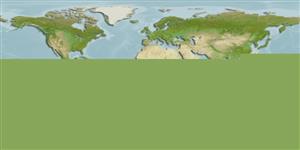>
Gobiiformes (Gobies) >
Gobiidae (Gobies) > Gobiinae
Etymology: Tryssogobius: Greek, tryo, tryso = to wear away + see under Gobius; sarah: Named for Sarah Crow; noun in apposition..
Environment: milieu / climate zone / depth range / distribution range
Écologie
marin récifal; profondeur 50 - 75 m (Ref. 90102). Subtropical
Distribution
Pays | Zones FAO | Écosystèmes | Occurrences | Point map | Introductions | Faunafri
Western Pacific: Indonesia, Papua New Guinea, Palau and Ryukyu Islands.
Taille / Poids / Âge
Maturity: Lm ? range ? - ? cm
Max length : 2.2 cm SL (female)
Description synthétique
Clés d'identification | Morphologie | Morphométrie
Épines dorsales (Total) : 6 - 7; Rayons mous dorsaux (Total) : 10; Épines anales: 1; Rayons mous anaux: 11; Vertèbres: 26. Characterized by pearly grey to whitish head and body; yellowish first dorsal fin except thin blue anterior margin and broad blue zone basally with yellow stripe; bluish second dorsal fin with pair of yellow strips; translucent caudal fin with blue-edged yellow band across upper and lower lobe; bluish anal fin with midlateral yellow stripe ending at acute posterior tip of fin; white pelvic fins with bluish posterior tip; dorsal rays VI+I,10; anal rays I,11; pectoral rays 17-18; cheeks with single row of scales; depth of body at level of pelvic fins 4.6-5.1 in SL; relatively narrow first dorsal fin, pointed at tip; pelvic fins reaching slightly beyond origin of anal fin, tip pointed; scales in longitudinal scale series 24-26; transverse scale rows 7-8; median predorsal scales 6, progressively larger anteriorly; body scales ctenoid to below posterior part of first dorsal fin, cycloid anteriorly; gill rakers 3-4+10-14; vertebrae 26 (Ref. 90102).
Occurs in areas exposed to relatively strong currents (Ref. 90102).
Life cycle and mating behavior
Maturities | Reproduction | Spawnings | Egg(s) | Fecundities | Larves
Allen, G.R. and M.V. Erdmann, 2012. Reef fishes of the East Indies. Perth, Australia: Universitiy of Hawai'i Press, Volumes I-III. Tropical Reef Research. (Ref. 90102)
Statut dans la liste rouge de l'IUCN (Ref. 130435)
Menace pour l'homme
Harmless
Utilisations par l'homme
Outils
Articles particuliers
Télécharger en XML
Sources Internet
Estimates based on models
Preferred temperature (Ref.
123201): 26.4 - 28.6, mean 27.3 °C (based on 44 cells).
Phylogenetic diversity index (Ref.
82804): PD
50 = 0.5078 [Uniqueness, from 0.5 = low to 2.0 = high].
Bayesian length-weight: a=0.00708 (0.00333 - 0.01504), b=3.09 (2.92 - 3.26), in cm total length, based on LWR estimates for this (Sub)family-body shape (Ref.
93245).
Niveau trophique (Ref.
69278): 3.1 ±0.3 se; based on size and trophs of closest relatives
Résilience (Ref.
120179): Haut, temps minimum de doublement de population inférieur à 15 mois (Preliminary K or Fecundity.).
Fishing Vulnerability (Ref.
59153): Low vulnerability (10 of 100).
